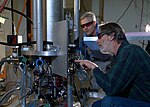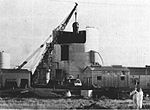The iodine clock reaction is a classical chemical clock demonstration experiment to display chemical kinetics in action; it was discovered by Hans Heinrich...
9 KB (991 words) - 14:03, 26 June 2024
for this clock reaction is the sulfite/iodate reaction or iodine clock reaction, also known as Landolt's reaction. Sometimes, a clock reaction involves...
5 KB (637 words) - 14:19, 11 October 2023
The iodine–starch test is a chemical reaction that is used to test for the presence of starch or for iodine. The combination of starch and iodine is intensely...
12 KB (1,287 words) - 02:10, 12 September 2024
Princeton University researching the inhibition of the iodine clock reaction (or Landolt reaction) by Hg2+, resulting in the formation of orange HgI2. Orange...
5 KB (423 words) - 18:20, 23 October 2022
to: Isotopes of iodine: Iodine-123 Iodine-124 Iodine-125 Iodine-129 Iodine-131 Iodine clock reaction Iodine (medical use) Povidone-iodine, a common antiseptic...
1,010 bytes (163 words) - 02:16, 1 July 2023
as a dark blue liquid smelling strongly of iodine. The first known homogeneous oscillating chemical reaction, reported by W. C. Bray in 1921, was between...
19 KB (2,250 words) - 07:34, 3 June 2024
December 1831 – 15 March 1910) was a Swiss chemist who discovered iodine clock reaction. He is also one of the founders of Landolt–Börnstein database. He...
7 KB (872 words) - 19:16, 12 September 2022
surfactants, such as perfluorooctanesulfonic acid. The iodine clock reaction (in which iodine also serves as a test for starch, forming a dark blue complex)...
107 KB (11,980 words) - 14:44, 28 September 2024
Chemical oscillator (redirect from Oscillating reaction)
formulation. The Bray–Liebhafsky reaction is a chemical clock first described by W. C. Bray in 1921 with the oxidation of iodine to iodate: 5 H2O2 + I2 → 2...
7 KB (838 words) - 00:08, 29 March 2024
The Bray–Liebhafsky reaction is a chemical clock first described by William C. Bray in 1921 and the first oscillating reaction in a stirred homogeneous...
5 KB (500 words) - 12:12, 2 May 2022
Chem-E-Car (section Example reactions)
variety of ways of dealing with this problem, such as an iodine clock reaction. This reaction works by using two clear solutions (many variations) that...
8 KB (1,111 words) - 15:27, 30 January 2024
Hans Heinrich Landolt (1831–1910), Swiss chemist who discovered iodine clock reaction. also one of the founders of Landolt-Börnstein database Jaqueline...
1,012 bytes (163 words) - 16:09, 24 January 2022
studied the rates of chemical reactions. Among the processes they investigated was the acid-catalyzed iodine clock reaction (iodide and hydrogen peroxide)...
8 KB (689 words) - 22:37, 4 September 2024
second expected during the 2030s. In July 2022, atomic optical clocks based on iodine molecules were demonstrated at-sea on a naval vessel and operated...
154 KB (16,261 words) - 19:21, 27 September 2024
Sodium thiosulfate (section Principal reactions)
component of iodine clock experiments. This particular use can be set up to measure the oxygen content of water through a long series of reactions in the Winkler...
14 KB (1,293 words) - 06:37, 8 September 2024
The Japanese reaction occurred after the Fukushima Daiichi nuclear disaster, following the 2011 Tōhoku earthquake and tsunami. A nuclear emergency was...
146 KB (17,605 words) - 19:29, 1 October 2024
Alkali metal (section Reaction with oxygen)
halogens (fluorine, chlorine, bromine, iodine, and astatine), forming salts known as the alkali metal halides. The reaction is very vigorous and can sometimes...
214 KB (23,508 words) - 12:55, 26 September 2024
Crystal oscillator (redirect from Oscillator clock)
used to keep track of time, as in quartz wristwatches, to provide a stable clock signal for digital integrated circuits, and to stabilize frequencies for...
89 KB (9,470 words) - 16:18, 27 August 2024
topography – Earthquake cycle – Fluorine cycle – Glaciation – Gold cycle – Iodine cycle – Iron cycle – Lead cycle – Lithium cycle – Manganese cycle – Mass...
9 KB (633 words) - 10:26, 28 September 2024
Caesium (section Atomic clocks)
neutron-rich fission products, passing through various isotopes of iodine and xenon. Because iodine and xenon are volatile and can diffuse through nuclear fuel...
93 KB (10,019 words) - 18:02, 23 September 2024
atmosphere aside from prompt neutrons, where known. The measured species is only iodine-131 if mentioned, otherwise it is all species. No entry means unknown, probably...
29 KB (2,831 words) - 17:46, 14 September 2024
Nuclear reactor (section By type of nuclear reaction)
reactor is a device used to initiate and control a fission nuclear chain reaction. Nuclear reactors are used at nuclear power plants for electricity generation...
98 KB (11,435 words) - 09:14, 26 September 2024
of cancer such as leukemia and thyroid cancer. The relationship between iodine-131 levels and thyroid cancer is still being researched. There are also...
74 KB (8,990 words) - 10:03, 27 July 2024
destructive force from nuclear reactions, either fission (fission bomb) or a combination of fission and fusion reactions (thermonuclear bomb), producing...
116 KB (13,243 words) - 08:59, 15 August 2024
alkylation reaction because whereas enamine radical cation was observed to cyclize onto pendant olefins and open cyclopropane radical clocks in SOMO catalysis...
50 KB (6,218 words) - 23:10, 8 February 2024
the reactor's core. The accident released about 80 curies (3.0 TBq) of iodine-131. This was not considered significant, due to its location in the remote...
63 KB (8,066 words) - 09:11, 18 September 2024
atmosphere aside from prompt neutrons, where known. The measured species is only iodine-131 if mentioned, otherwise it is all species. No entry means unknown, probably...
26 KB (1,573 words) - 08:30, 26 September 2024
of uranium are formed by direct reaction of, respectively, bromine and iodine with uranium or by adding UH 3 to those element's acids. Known examples...
110 KB (12,358 words) - 06:51, 17 September 2024
166–169. Bray, William C.; Liebhafsky, Herman A (1931). "Reactions involving hydrogen peroxide, iodine and iodate ion. I. Introduction". Journal of the American...
6 KB (649 words) - 08:17, 4 February 2024





















